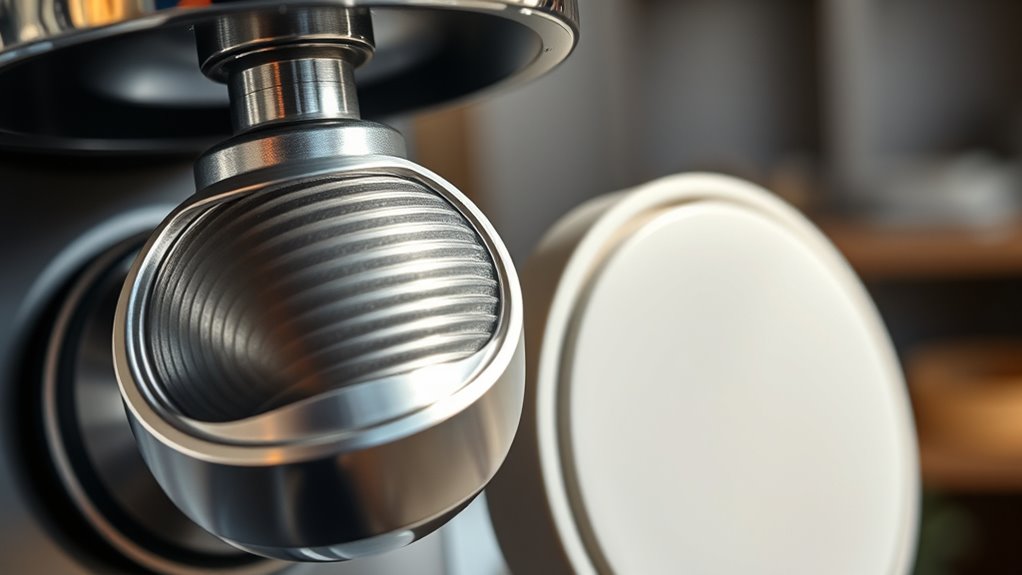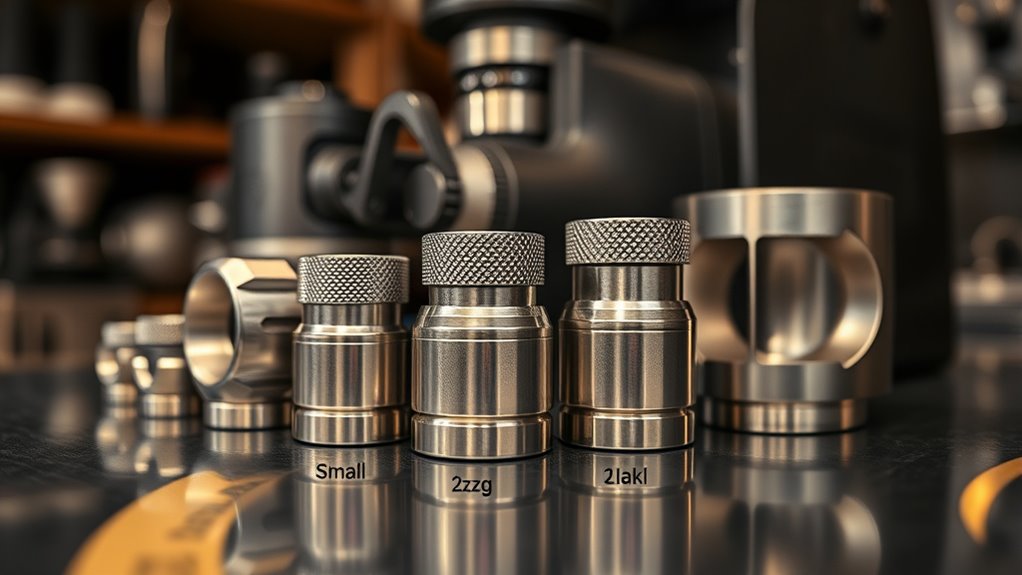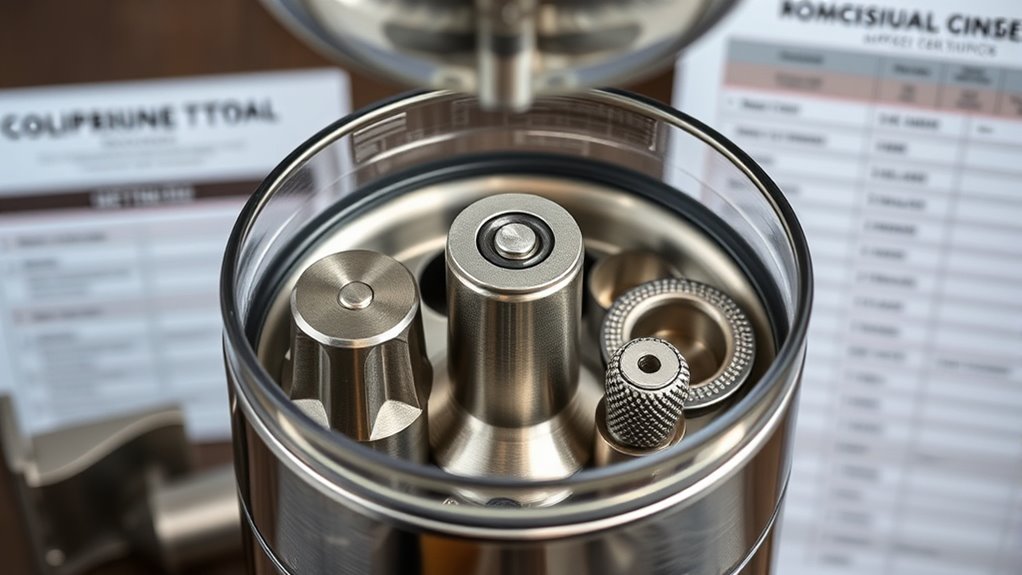When choosing grinder burrs, consider the material—stainless steel offers strength and corrosion resistance, while ceramic provides hardness and heat resistance but can be brittle. Decide between flat burrs, which deliver a uniform grind and better extraction but are noisier and pricier, or conical burrs, which operate more quietly and handle wider grind ranges. Additionally, look at the burr size; larger burrs provide faster, more consistent grinding. Keep these factors in mind, and you’ll learn more about optimizing your grinder.
Key Takeaways
- Identify burr material options: stainless steel, ceramic, or hardened steel, considering durability, heat resistance, and brittleness risks.
- Determine burr shape: flat for uniform grind and extraction, conical for quieter operation and heat dissipation.
- Assess burr size: larger burrs offer faster, more consistent grinding; medium-sized balance performance and cost.
- Look for specialty features: noise reduction, enhanced durability, and consistency-enhancing design elements.
- Regularly maintain and clean burrs to optimize performance and prolong lifespan based on material and construction quality.
Types of Burr Materials and Construction

Have you ever wondered what makes some burrs more durable or efficient than others? It all comes down to the burr material and construction. High-quality materials like stainless steel, ceramic, and hardened steel offer superior burr material durability, ensuring your grinder lasts longer and maintains sharpness over time. Stainless steel is common for its strength and resistance to corrosion, while ceramic burrs are prized for their hardness and heat resistance, though they can be more brittle. Proper construction maintenance tips include regular cleaning, checking for wear, and avoiding moisture buildup that can cause rust or corrosion. Additionally, burr material properties play a crucial role in determining overall grinder performance. Choosing the right material and keeping your burrs in top condition helps optimize grind consistency and extends the lifespan of your grinder.
Flat Burrs vs. Conical Burrs: Key Differences

Understanding the key differences between flat and conical burrs can help you choose the right grinder for your brewing needs. Flat burrs typically produce more grind uniformity, resulting in consistent particle size and better extraction. They also tend to generate higher noise levels, which might be a consideration if you value a quieter environment. Conical burrs usually operate more quietly and handle a wider range of grind sizes, making them versatile. Their conical shape facilitates better heat dissipation, reducing the risk of overheating. While flat burrs excel in producing uniform grinds, they may be louder and more expensive. Conical burrs offer a quieter operation and are often more affordable, but their grind uniformity can vary slightly depending on the model. Your choice depends on your priorities for noise, consistency, and budget. Additionally, understanding AI security vulnerabilities can help in selecting safer and more reliable equipment.
Burr Size and Its Impact on Grinding Performance

Burr size plays a significant role in determining a grinder’s overall performance and the quality of your brew. Larger burrs generally produce more consistent grinds and better heat dissipation, leading to improved grind consistency. Smaller burrs may be more affordable but often sacrifice uniformity and speed. The table below highlights how burr size influences key factors:
| Burr Size | Grind Consistency | Grinding Speed |
|---|---|---|
| Large (75mm+) | Excellent | Faster |
| Medium (50-75mm) | Good | Moderate |
| Small (<50mm) | Variable | Slower |
| Very Large | Superior | Very Fast |
| Very Small | Less Consistent | Slow |
Choosing the right grinder burr size depends on your brewing needs, but larger burrs generally enhance grind consistency and efficiency. Additionally, burr size can impact the longevity and maintenance requirements of your grinder, making it an important consideration for long-term use.
Specialty Burr Features and Their Benefits

Specialty burr features are designed to enhance your grinder’s performance and improve the quality of your brew. They optimize grind consistency, ensuring each cup is uniform and flavorful. Additionally, these features often reduce noise levels, making your grinding quieter and more pleasant.
Here are three key benefits:
- Improved Grind Consistency: Specialty burrs produce uniform grinds, which lead to better extraction and taste.
- Lower Noise Levels: Advanced burr designs minimize noise, creating a more comfortable brewing environment.
- Enhanced Durability: These features often extend burr lifespan, maintaining performance over time.
Frequently Asked Questions
Which Burr Type Is Best for Espresso Grinding?
Imagine a tiny army perfectly aligned, ready to conquer your espresso beans. That’s what you need—a burr with impeccable burr alignment—ensuring your grind size is consistent and fine. A conical burr excels here, providing precise, uniform grounds essential for rich espresso shots. You want a burr that’s as disciplined as a drill sergeant, turning your coffee into a symphony of flavor, not a chaotic mess.
How Do Burrs Affect Coffee Flavor Extraction?
Burrs directly impact coffee flavor extraction by providing a consistent grind size, which guarantees even extraction. When burrs wear out, they produce uneven grounds, leading to inconsistent flavors and over- or under-extraction. Regularly checking for burr wear helps maintain flavor consistency, so your coffee always tastes its best. Keep your burrs sharp and well-maintained to optimize extraction and maximize the rich flavors in each brew.
Are Ceramic Burrs More Durable Than Steel?
You might think ceramic burrs are more durable, but that’s ironic—while ceramic longevity prevents rust and corrosion, they can chip or crack under pressure. Steel burrs, on the other hand, resist steel wear over time, making them surprisingly tough. So, if you’re after long-lasting performance, steel might actually outperform ceramic, which can be fragile despite its initial durability. Sometimes, appearances deceive even the savviest coffee enthusiasts.
Can Burrs Be Replaced or Upgraded?
Yes, you can replace or upgrade your grinder burrs. Depending on your burr material—whether ceramic or steel—upgrading options include switching to a higher-quality material or a different burr type for better performance. To upgrade, remove the existing burrs carefully, then install the new ones, ensuring compatibility with your grinder model. Upgrading your burrs can improve grind consistency, flavor, and overall brewing quality.
What Maintenance Is Required for Different Burr Types?
Think of your grinder like a finely tuned orchestra—each burr needs to perform harmoniously. Regular burr sharpening keeps them cutting smoothly, while timely burr replacement prevents a discordant grind. For different burr types, you should clean them regularly, inspect for wear, and follow manufacturer guidelines. Proper maintenance guarantees consistent flavor, reduces clogs, and extends your grinder’s life, making every brew a perfect symphony.
Conclusion
So, after all this talk about burr types and sizes, you’d think choosing the perfect grinder is a no-brainer, right? Turns out, all those details might just be overkill — or maybe not. Because in the end, no matter how fancy your burrs are, it’s your coffee that truly matters. Irony? The best grind might just be the one you’re too busy obsessing over to enjoy. Cheers to your perfect brew!










